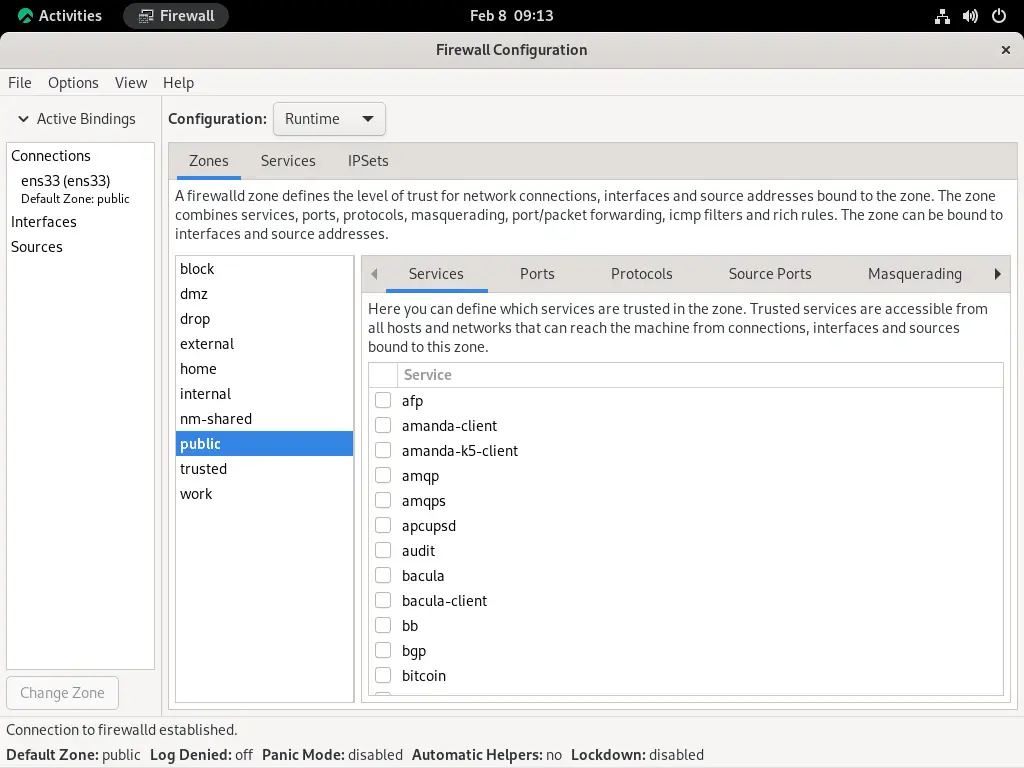Securing Linux Systems With Firewalld

Firewalld is a powerful firewall management tool that provides a simple and intuitive interface for configuring and managing firewalls on Linux systems. It is the default firewall solution for many popular Linux distributions, including CentOS, Fedora, and Red Hat Enterprise Linux.

Firewalld uses a zone-based approach to firewall configuration. A zone is a collection of rules that define which network traffic is allowed to enter or leave a system. Firewalld comes with a set of predefined zones, such as the “public” zone, which allows all incoming traffic, and the “private” zone, which blocks all incoming traffic.

To manage Firewalld, you can use either the command line interface (CLI) or the graphical user interface (GUI). The CLI is more powerful and flexible, but the GUI is easier to use for beginners.
To enable Firewalld, you can use the following command:
systemctl start firewalldTo check the status of Firewalld, you can use the following command:
systemctl status firewalldTo list the available zones, you can use the following command:
firewall-cmd --list-zonesTo create a new zone, you can use the following command:
firewall-cmd --new-zone=myzoneTo add a rule to a zone, you can use the following command:
firewall-cmd --zone=myzone --add-rule=service=http --permanentTo remove a rule from a zone, you can use the following command:
firewall-cmd --zone=myzone --remove-rule=service=http --permanentTo save your changes, you can use the following command:
firewall-cmd --runtime-to-permanentFirewalld is a powerful and flexible firewall management tool that can be used to secure Linux systems. By using Firewalld, you can easily configure and manage your firewall to protect your system from unauthorized access.## [Securing Linux Systems With Firewalld]
Executive Summary
Firewalld is a dynamic firewall management tool for Linux systems that offers a simple and comprehensive approach to managing firewall configurations. This article provides a detailed overview of Firewalld, highlighting its key features, benefits, and best practices for implementing it effectively to enhance the security of Linux systems.
Introduction
In the digital landscape, securing systems from unauthorized access and malicious threats is paramount. Firewalld is a powerful firewall tool that empowers Linux system administrators to establish robust security measures. This comprehensive guide explores the intricate details of Firewalld, enabling readers to harness its capabilities for optimal system protection.
Firewalld Overview
Firewalld operates as a front-end for the Netfilter framework, a powerful set of packet filtering rules at the heart of Linux’s networking stack. Firewalld simplifies firewall management by providing a user-friendly interface and a rich set of features that cater to diverse security needs.
Key Features and Benefits
-
Simplified Configuration: Firewalld’s intuitive user interface and XML-based configuration files make it easy to manage firewall settings, even for less experienced users.
-
Zones and Services: Firewalld organizes rules into logical zones, representing different network interfaces and trust levels. This modular approach allows for granular control over traffic flow.
-
Dynamic Updates: Firewalld allows rules to be applied dynamically, without the need for a system reboot. This flexibility enables administrators to make real-time adjustments to firewall configurations.
-
IPv6 Support: Firewalld seamlessly supports IPv6, ensuring comprehensive protection for networks using both IPv4 and IPv6 protocols.
-
IPTables Compatibility: Firewalld maintains compatibility with the traditional iptables tool, allowing administrators to leverage existing knowledge and resources.
Best Practices for Implementing Firewalld
-
Establish Clear Zones: Define distinct zones to represent different levels of trust and network access, such as external, internal, DMZ, and trusted zones.
-
Default Zones: Set appropriate default zones for network interfaces to ensure consistent firewall behavior and reduce the risk of vulnerabilities.
-
Logging and Monitoring: Enable logging and monitoring to track firewall activity, identify suspicious events, and detect potential threats.
-
Limited Rules: Implement only the necessary firewall rules to minimize the attack surface and prevent unnecessary exposure to vulnerabilities.
-
Secure Services: Carefully configure firewall rules for specific services, allowing only essential ports and protocols to prevent unauthorized access.
-
Regular Reviews: Regularly review firewall configurations to ensure they align with evolving security requirements and remain effective against emerging threats.
Conclusion
Firewalld is an indispensable tool for securing Linux systems, offering a blend of simplicity, flexibility, and advanced security features. By implementing best practices for firewall configuration and adhering to sound security principles, system administrators can leverage Firewalld to establish robust defenses against cyber threats and safeguard the integrity of their systems in the face of evolving security challenges.
Keyword Phrase Tags
- Linux Security
- Firewall Management
- Firewalld
- Network Protection
- Cybersecurity

Firewalld is the best firewall ever! It’s so easy to use, even a caveman could do it.
Firewalld is a piece of crap. It’s too complicated and doesn’t work half the time.
Firewalld is a powerful firewall that can be used to protect your Linux system from a variety of threats. It’s easy to configure and use, and it’s a great choice for both home and business users.
Firewalld is a joke. It’s full of holes that any half-decent hacker could exploit.
Firewalld is like a clown car. It’s colorful and fun, but it’s not very effective.
Firewalld is the best firewall ever…if you’re a complete idiot.
Firewalld is like a bad joke. It’s not funny, and it doesn’t make any sense.
firewalld is a powerfull firewall. i ts easy to learn. You can setting quickly but it works perfectly
Firewad is an amazing firewall but you need knoledge about it. not for newbies
firewalld is the best, no other firewall can do that. Be carefull setting the zones
for using firewalld you need do a course first!!
firewhat?? oh yeah, i know firewhat, is a piece of crap, dont use it
fireawall? who need a firewall, is just nice name